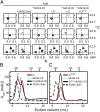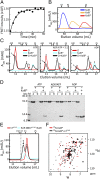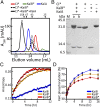Rhythmic ring-ring stacking drives the circadian oscillator clockwise
- PMID: 22967510
- PMCID: PMC3479483
- DOI: 10.1073/pnas.1211508109
Rhythmic ring-ring stacking drives the circadian oscillator clockwise
Abstract
The oscillator of the circadian clock of cyanobacteria is composed of three proteins, KaiA, KaiB, and KaiC, which together generate a self-sustained ∼24-h rhythm of phosphorylation of KaiC. The mechanism propelling this oscillator has remained elusive, however. We show that stacking interactions between the CI and CII rings of KaiC drive the transition from the phosphorylation-specific KaiC-KaiA interaction to the dephosphorylation-specific KaiC-KaiB interaction. We have identified the KaiB-binding site, which is on the CI domain. This site is hidden when CI domains are associated as a hexameric ring. However, stacking of the CI and CII rings exposes the KaiB-binding site. Because the clock output protein SasA also binds to CI and competes with KaiB for binding, ring stacking likely regulates clock output. We demonstrate that ADP can expose the KaiB-binding site in the absence of ring stacking, providing an explanation for how it can reset the clock.
Conflict of interest statement
The authors declare no conflict of interest.
Figures




Comment in
-
Bacterial physiology: uncovering the circadian clockwork.Nat Rev Microbiol. 2012 Nov;10(11):730. doi: 10.1038/nrmicro2896. Epub 2012 Oct 8. Nat Rev Microbiol. 2012. PMID: 23042565 No abstract available.
-
Orderly wheels of the cyanobacterial clock.Proc Natl Acad Sci U S A. 2012 Oct 16;109(42):16760-1. doi: 10.1073/pnas.1214901109. Epub 2012 Oct 8. Proc Natl Acad Sci U S A. 2012. PMID: 23045681 Free PMC article. No abstract available.
Similar articles
-
Nature of KaiB-KaiC binding in the cyanobacterial circadian oscillator.Cell Cycle. 2013 Mar 1;12(5):810-7. doi: 10.4161/cc.23757. Epub 2013 Feb 6. Cell Cycle. 2013. PMID: 23388462 Free PMC article.
-
Cooperative KaiA-KaiB-KaiC interactions affect KaiB/SasA competition in the circadian clock of cyanobacteria.J Mol Biol. 2014 Jan 23;426(2):389-402. doi: 10.1016/j.jmb.2013.09.040. Epub 2013 Oct 7. J Mol Biol. 2014. PMID: 24112939 Free PMC article.
-
Cooperative Binding of KaiB to the KaiC Hexamer Ensures Accurate Circadian Clock Oscillation in Cyanobacteria.Int J Mol Sci. 2019 Sep 13;20(18):4550. doi: 10.3390/ijms20184550. Int J Mol Sci. 2019. PMID: 31540310 Free PMC article.
-
[Progress in the molecular mechanism of KaiA regulating cyanobacterial circadian clock].Sheng Wu Gong Cheng Xue Bao. 2019 May 25;35(5):795-804. doi: 10.13345/j.cjb.190020. Sheng Wu Gong Cheng Xue Bao. 2019. PMID: 31222998 Review. Chinese.
-
Intricate protein-protein interactions in the cyanobacterial circadian clock.J Biol Chem. 2014 Aug 1;289(31):21267-75. doi: 10.1074/jbc.R114.579607. Epub 2014 Jun 16. J Biol Chem. 2014. PMID: 24936066 Free PMC article. Review.
Cited by
-
KidA, a multi-PAS domain protein, tunes the period of the cyanobacterial circadian oscillator.Proc Natl Acad Sci U S A. 2022 Sep 13;119(37):e2202426119. doi: 10.1073/pnas.2202426119. Epub 2022 Sep 6. Proc Natl Acad Sci U S A. 2022. PMID: 36067319 Free PMC article.
-
A protocol for preparing nucleotide-free KaiC monomer.Biophysics (Nagoya-shi). 2015 Mar 21;11:79-84. doi: 10.2142/biophysics.11.79. eCollection 2015. Biophysics (Nagoya-shi). 2015. PMID: 27493519 Free PMC article.
-
Robust and tunable circadian rhythms from differentially sensitive catalytic domains.Proc Natl Acad Sci U S A. 2013 Jan 15;110(3):1124-9. doi: 10.1073/pnas.1212113110. Epub 2012 Dec 31. Proc Natl Acad Sci U S A. 2013. PMID: 23277568 Free PMC article.
-
Orderly wheels of the cyanobacterial clock.Proc Natl Acad Sci U S A. 2012 Oct 16;109(42):16760-1. doi: 10.1073/pnas.1214901109. Epub 2012 Oct 8. Proc Natl Acad Sci U S A. 2012. PMID: 23045681 Free PMC article. No abstract available.
-
Elucidation of master allostery essential for circadian clock oscillation in cyanobacteria.Sci Adv. 2022 Apr 15;8(15):eabm8990. doi: 10.1126/sciadv.abm8990. Epub 2022 Apr 15. Sci Adv. 2022. PMID: 35427168 Free PMC article.
References
-
- Hogenesch JB, Ueda HR. Understanding systems-level properties: Timely stories from the study of clocks. Nat Rev Genet. 2011;12:407–416. - PubMed
-
- Ishiura M, et al. Expression of a gene cluster kaiABC as a circadian feedback process in cyanobacteria. Science. 1998;281:1519–1523. - PubMed
-
- Tomita J, Nakajima M, Kondo T, Iwasaki H. No transcription-translation feedback in circadian rhythm of KaiC phosphorylation. Science. 2005;307:251–254. - PubMed
-
- Nakajima M, et al. Reconstitution of circadian oscillation of cyanobacterial KaiC phosphorylation in vitro. Science. 2005;308:414–415. - PubMed
Publication types
MeSH terms
Substances
Grants and funding
LinkOut - more resources
Full Text Sources
Other Literature Sources

